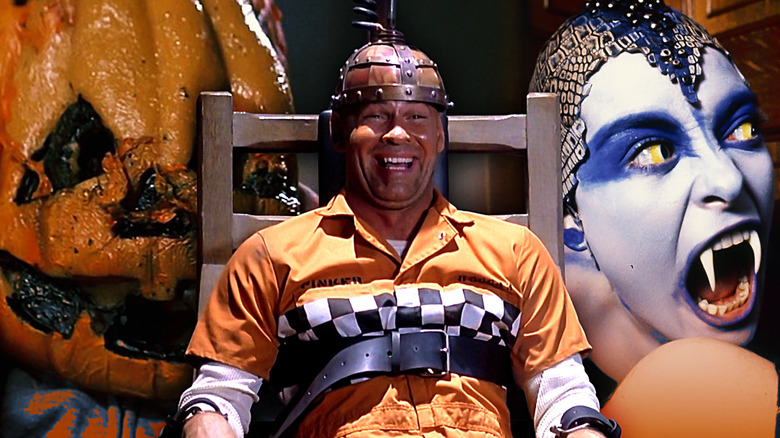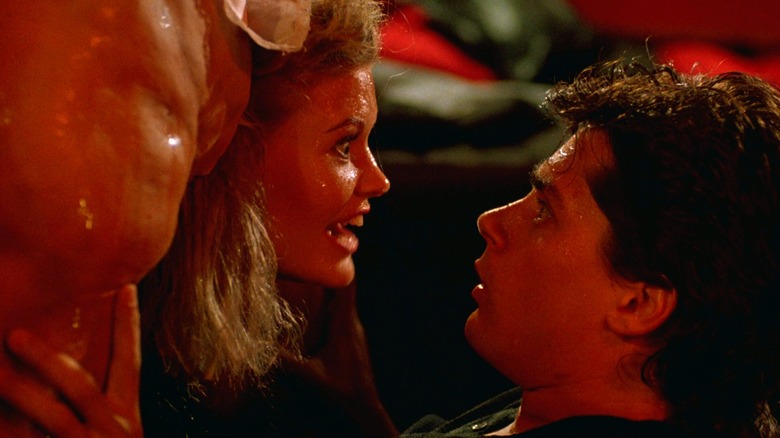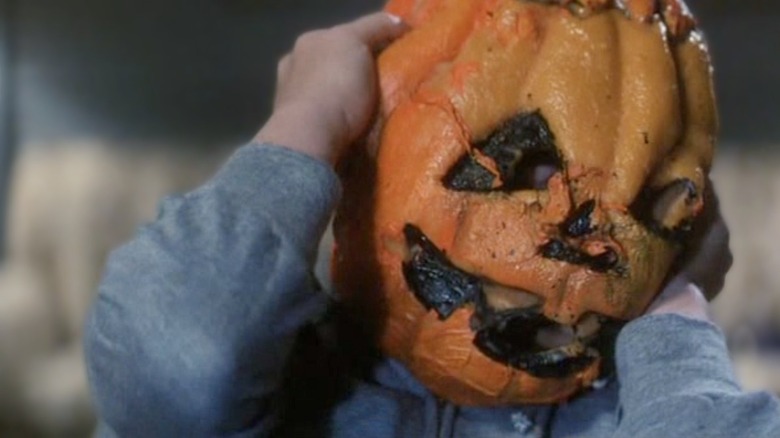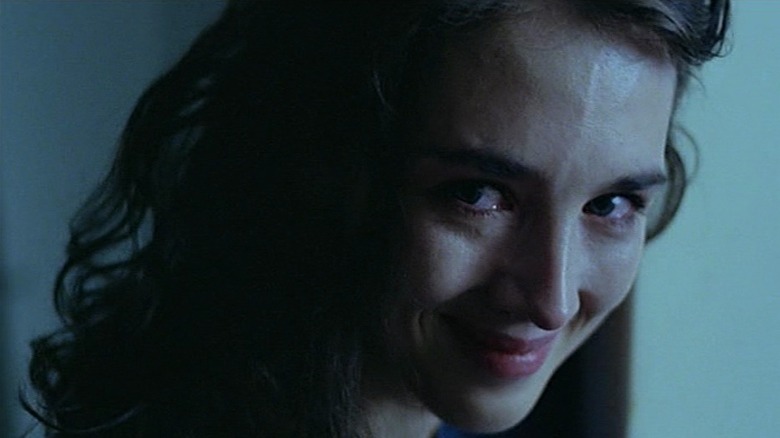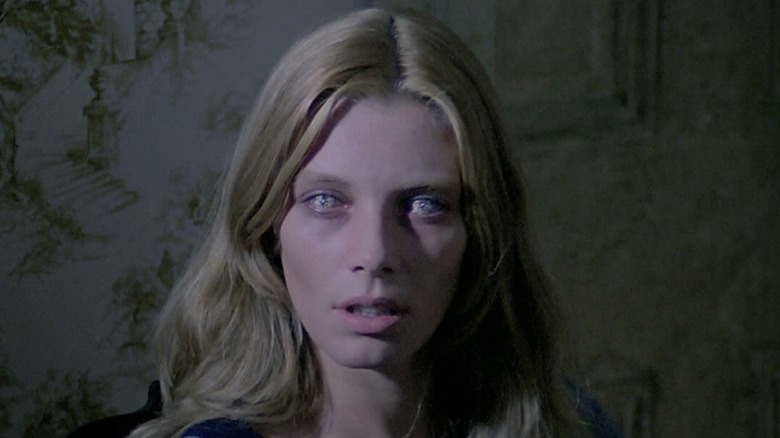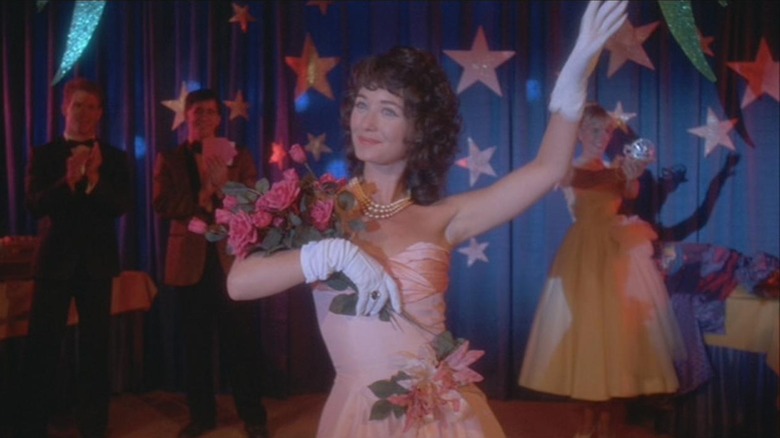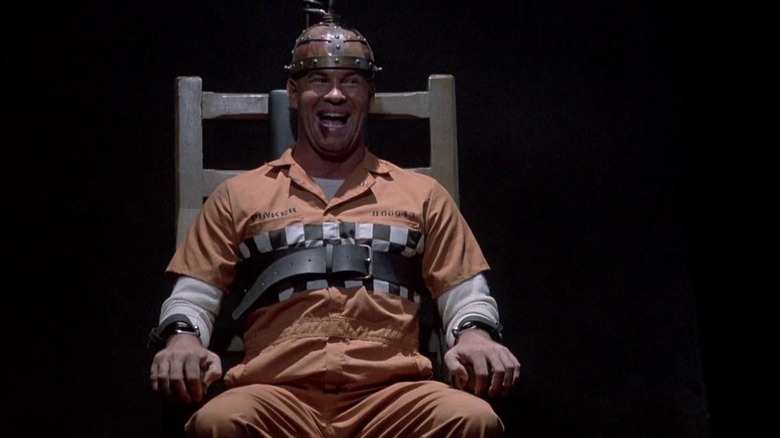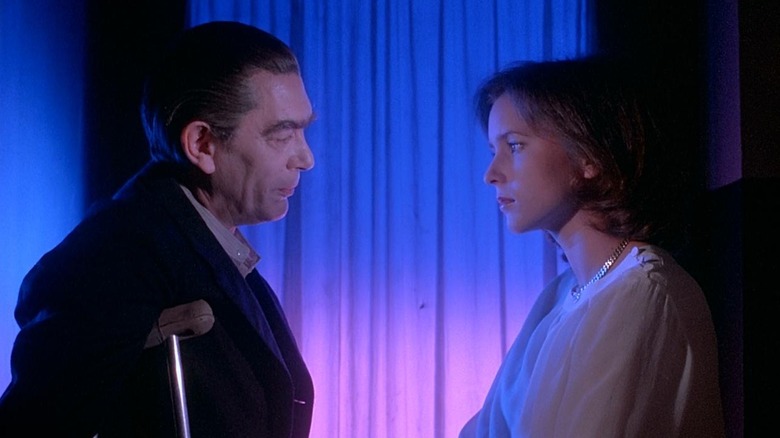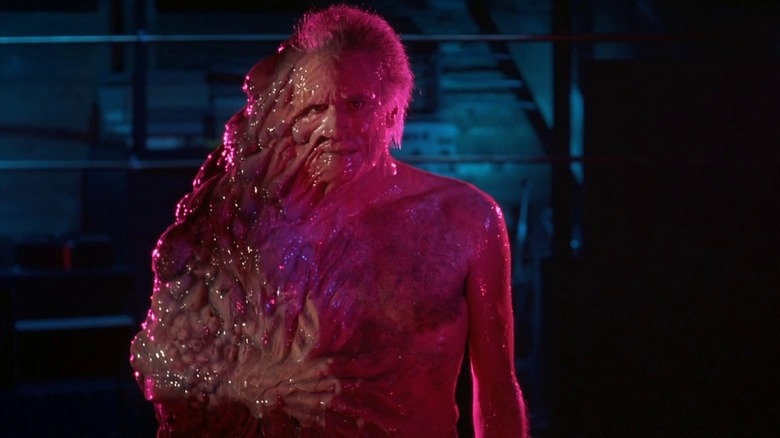The 10 Most Underrated '80s Horror Movies You Need To Watch
We may receive a commission on purchases made from links.
There may be no other decade more directly associated with classic horror in the general public consciousness than the 1980s. This is the decade of the slasher genre-shaping "Friday the 13th," of Freddy Krueger famously saving New Line Cinema with "A Nightmare on Elm Street," of Sam Raimi blowing open the doors of independent filmmaking with "The Evil Dead," and of dead-on-arrival bombs turned cult classics like John Carpenter's "The Thing."
The corruption of the Ronald Reagan presidency, if nothing else, proved to be fertile ground for the horror genre's dread and bloodshed. But as always, not all films are created equal — and neither is the public's reception to them. The '80s are chock-full of unseen or under-appreciated gems that stand up to the canonized classics of the era, from disregarded franchise sequels to overlooked ventures from American and international genre masters. There's a wealth of riches (and blood, guts, hacking, slashing, creatures, monsters, ghouls, goblins, ghosts, etc.) to be found within what feels like an endless depth of hidden '80s horror treasures.
Here are the most underrated '80s horror movies that you need to watch.
Society
Here's a horror movie for anyone who enjoys feeling absolutely sick to their stomach while taking in their evening entertainment. "Society" is one of the greatest — and grossest — displays of disgusting body horror ever unleashed on theater screens, and it also serves as a sharp skewering of an America that, by 1989, had further cemented itself as a hierarchical landmine of wealth inequality.
We follow Bill Whitney (Billy Warlock), an everyday teen in Beverly Hills whose unease toward his wealthy family is proven justified when he begins to suspect they might be involved in some kind of freaky sex-murder cult. His paranoia-fueled quest to uncover the secrets lurking beneath the polished surface of his life couldn't possibly prepare him — or the viewer — for the extended climax that defines the movie's entire filmic ethos. Producer of Stuart Gordon's first movie, "Re-Animator", Brian Yuzna, making his directorial debut, teams up with legendary horror effects artist Screaming Mad George to deliver a finale of carnal, fleshy madness that rivals the most stomach-churning entries in the body horror genre.
The result is a striking piece of '80s horror that's as grotesque as it is perceptive in its depiction of class disparity, a gap that would only widen in the decades to follow. The elite may not actually be engaging in erotic, body-melding orgies, but the fact that the premise of "Society" feels immediately plausible says a lot all on its own.
Halloween III: Season of the Witch
It's no surprise that when you label your movie "Halloween III" and fail to deliver the eerily stalking menace of Michael Myers, audiences might bounce right off it. Instead of suburban slashing, "Halloween III: Season of the Witch" offers a completely different kind of horror story — one that baffled moviegoers in 1982. Had they simply dropped the "III," this third entry in the John Carpenter and Debra Hill-produced franchise might have found success on its own terms. Alas, it would take decades for "Halloween III: Season of the Witch" to earn its cult following.
Intended as the first in a new anthology series under the "Halloween" banner, "Halloween III" was a standalone story that bombed hard enough to bring Michael Myers back in "Halloween IV: The Return of Michael Myers." But even without the franchise baggage, "Season of the Witch" is weird enough that a polarizing response was probably inevitable. Tom Atkins plays an alcoholic doctor who teams up with Stacey Nelkin to investigate strange goings-on in Santa Mira, California, where the Silver Shamrock Novelties company is pushing a line of Halloween masks for kids — with sinister intent.
The film blends science fiction and supernatural horror in a story involving androids, shadowy men, and a plot to revive ancient pagan rituals of mass sacrifice. The subtitle "Season of the Witch" barely makes sense, but that adds to the strange charm. Director Tommy Lee Wallace leans into the weird, crafting a spooky, singular entry in '80s horror that feels tailor-made for that familiar chill of October. Considering its competition, "Halloween III: Season of the Witch" may be the best "Halloween" sequel.
Possession
Polish director Andrzej Żuławski's surrealistic supernatural horror film was met by a cool reception and limited release in 1981. Today, in certain circles, "Possession" is considered a horror classic. A divorce drama by way of gonzo theatricality, enigmatic plot developments, and absolutely deranged sequences of metaphysical and creature horror, "Possession" is a movie that asks viewers to hold on for dear life as it makes its way through its manic story of the dissolution of two lovers.
Made amid Żuławski's own torrid divorce, it reads as an existential panic attack, with the director positioning the dynamic between his two leads in any severe way necessary to get the maximum amount of impact from their personal afflictions, externalizing the demons they've absorbed from their creator into atrocious, confusing beasts and effusions.
Sam Neill as Mark tries to maintain the ever-slipping reality of his world against the increasingly unstable Anna, played by Isabelle Adjani in one of the best and most uninhibited horror performances of all time. She is the centerpiece of one of the greatest scenes of berserk physical lunacy ever committed to film, as Anna writhes around screaming and shrieking amid her own bodily secretions in the filth of a subway tunnel. By the time it introduces doppelgängers, it should be no secret that "Possession" is an acquired taste, but those who understand its unrestrained rhythms will find a horror movie representing a singular type of reckless abandon.
The Beyond
Lucio Fulci's "The Beyond" gets to the heart of the type of surreal aberration that typically accompanies Italian horror. A Southern Gothic supernatural thriller about a Louisiana hotel that may or may not be situated on a gateway to hell, "The Beyond" sees Fulci at his most disorienting and legitimately scary, carving out a vision of a world that is doomed to a hellish fate that it has no control over.
He accomplishes this via his reliable sense of nightmarish imagery and jarring moments of violence, and amplifies it via a discombobulating plot, making the viewers feel as hopelessly lost and confused as the characters attempting to navigate their way through an inescapable condemnation. "The Beyond" delivers on every horror set piece you could ever hope for with ravishing, brutal practical effects, including ravenous tarantulas, skewered eyeballs, zombies clawing their way back to Earth, and a final liminal threshold realm that carries a heavy, disturbing weight of inevitability. It's one of the best Italian horror movies of all time.
Prince of Darkness
The middle chapter of John Carpenter's so-called "apocalypse trilogy" — accidentally starting with "The Thing" and rounding out with "In The Mouth of Madness" — "Prince of Darkness" potentially best represents the inevitable cosmic doom that encompasses the runtimes of each film. It features some of the legendary horror director's most unsettling imagery and houses the greatest existential sense of terror of his entire body of work, anchored around a broadcast from the future foretelling imminent, inescapable ruin.
Carpenter expands his sense of terror from the immediacy of Michael Myers' blade or the morphing form of an alien life form into a slow-burn, simmering tension as a group of quantum psychics graduate students investigates an ominous container of liquid in a monastery that appears to be the physical manifestation of Satan. Carpenter isn't myopic enough to not afford such a heightened concept a certain degree of tongue-in-cheek awareness, and there's some comic relief on behalf of our incredulous and ill-fated protagonists. But then that just makes the ultimate sense of dread Carpenter imparts as events drag on even more unsettling, as a simple understanding of the world is ruptured by the arrival of evil forces much greater than any of these characters could ever handle.
The Lair of the White Worm
You can only really set proper expectations for "The Lair of the White Worm" if you're familiar with the work of its director, the often controversial and eccentric Ken Russell. The English filmmaker was known for his blasphemous inclinations, sexual perversions, and mind-altering surrealism found within startling religious dramas ("The Devils"), sci-fi head-trips ("Altered States"), and wackadoo horror comedies, such as "The Lair of the White Worm."
Loosely based on Bram Stoker's 1911 novel of the same name, "The Lair of the White Worm" is a folk horror tale that carries an undercurrent of droll humor about its own ridiculous nature. It follows a slew of residents in rural Britain — including early-career roles from a baby-faced Hugh Grant and Peter Capaldi — as a supernatural conspiracy involving a monstrous serpent is unveiled within their peaceful hamlet. It's never particularly frightening, but it does fulfill the Ken Russell quota of bizarre, freaked-out mixed media hallucinogenic, sexually-charged horror set-pieces.
And, yes, there is eventually a giant practical worm monster that people are sacrificing virgins to, as well as a batch of characters running around with prosthetic fangs. Russell devises a heightened creature feature just self-aware enough to make its horror elements feel genuinely strange and uncanny, resulting in the type of movie only he could make.
Hello Mary Lou: Prom Night II
The first "Prom Night" film is a fairly forgettable piece of familiar '80s slasher fare, mostly capitalizing on the presence of its stars Leslie Nielsen and Jamie Lee Curtis while never exceeding the quality of some of its more impressive contemporaries. On the flip side, the underseen seven-year-later sequel "Hello Mary Lou: Prom Night II" builds on that film's base premise to craft what is secretly one of the great horror sequels.
To be fair to audiences, there's no reason to think that "Hello Mary Lou: Prom Night II" is any good: it received expectedly mixed reviews, has a bit of a low-rent aesthetic, and originally started production as a meta horror called "The Haunting of Hamilton High," only rebranding to a "Prom Night" sequel after extensive reshoots. But though it may initially seem like a cheapie cash-in on the popularity of a second-rate slasher, "Hello Mary Lou" is actually a crazed, sleazy possession picture to slot in with some of the best of the subgenre, acting as a shameless amalgamation of "The Exorcist," "Carrie," and "A Nightmare On Elm Street," and taking the story to the absurd extremes that such a mixture implies.
It's a film full of memorable imagery and kills, and features Michael Ironside providing more gravitas than is perhaps deserved, as well as Lisa Schrage, wild as the provoked protagonist who turns bloodthirsty, suggesting a great career that never got off the ground.
Shocker
Freddy Krueger may be Wes Craven's greatest horror creation to have come out of the '80s, but I think it's high time that we pay our respects to Horace Pinker (Mitch Pileggi) of "Shocker." Besides, Pinker and Krueger feel harmonious with each other, making "Shocker" rhyme plenty with "A Nightmare on Elm Street" even as two separate compositions.
"Shocker" feels like Craven throwing the guidelines of '80s horror, and of his own filmography, at the wall and seeing what kind of shape the splatter takes on. It's about 10 different positively deranged movies all synthesized together into a crazy techno-slasher freak out, with Craven maintaining the dream logic of "Elm Street" and pushing it to madcap heights. I doubt you'll find many other slashers focused on a serial killer who turns to black magic to evolve into a physical manifestation of electricity who can possess people at will, out to kill a teenager with whom he has a psychic connection. Oh, and that teen (Peter Berg as Jonathan Parker) also has a supernatural link to his ghost girlfriend, who comes to him in visions.
You'll have thought you've seen it all by the climax, which then once again upends your expectations as it pits our characters on a frantic chase with each other through television stations. At every turn, true to his entire body of work, Craven has a new, wild concoction up his sleeve, and "Shocker" is overdue for its horror flowers.
Inferno
Italian horror maestro Dario Argento followed up his masterpiece and surprise 1977 hit "Suspiria" with the second movie in his "Three Mothers" trilogy (the last one, "The Mother of Tears," would be delayed until 2007), inspired by Thomas de Quincey's "Suspiria de Profundis." With a botched North American theatrical release and mixed reviews coming off the rousing success of his immediately previous work, "Inferno" was left in a prime position for decades of neglect.
That's a shame, because "Inferno" is Argento at some of his most visually stunning, atmospherically haunted, and totally raving and perplexing. "Inferno" sees Argento stripping his style down to the bare essentials: centered on a supernatural tale of murder and witchcraft, featuring the same masterful use of beautifully lurid, neon lighting established in "Suspiria," and composed of his reliably wonderful sequences of bloody tension.
Argento has never been particularly known for compelling character work, and with this entry, you'll especially have to check your expectations at the door as far as engaging dialogue or a coherent plot. On the contrary, "Inferno" quite proudly plays up its baffling perposterousness, more than happy to drop all those ancillary elements of filmmaking to deliver a vivid mood piece that coasts on its ambient vibes.
From Beyond
Before directing "Society," Brian Yuzna produced this H.P. Lovecraft adaptation, directed by horror legend Stuart Gordon. "From Beyond" reunites Gordon with Jeffrey Combs and Barbara Crampton following "Re-Animator" for a gross-out body horror extravaganza that's as much an exhibition of corporeal grotesquerie as it is a journey into kinky sexual liberation.
The story centers on the development of a machine that stimulates the pineal gland, unlocking access to a parallel dimension teeming with violently carnal creatures eager to absorb a group of unprepared scientists into their world of savage ecstasy. When lead scientist Dr. Edward Pretorius is transformed by this alternate reality and returns to the lab, it's as an impossibly revolting, wet, mutated monster bent on devouring minds and guiding others toward his grotesque vision of enlightenment.
"From Beyond" may not be overly scary, but it's driven by a gleeful sense of bad taste and a firm commitment to fusing violence with sexual perversion. Featuring some of the most memorable practical effects in horror history, it's a vivid reminder of a time when horror was a little more tactile— and a lot more bonkers.
